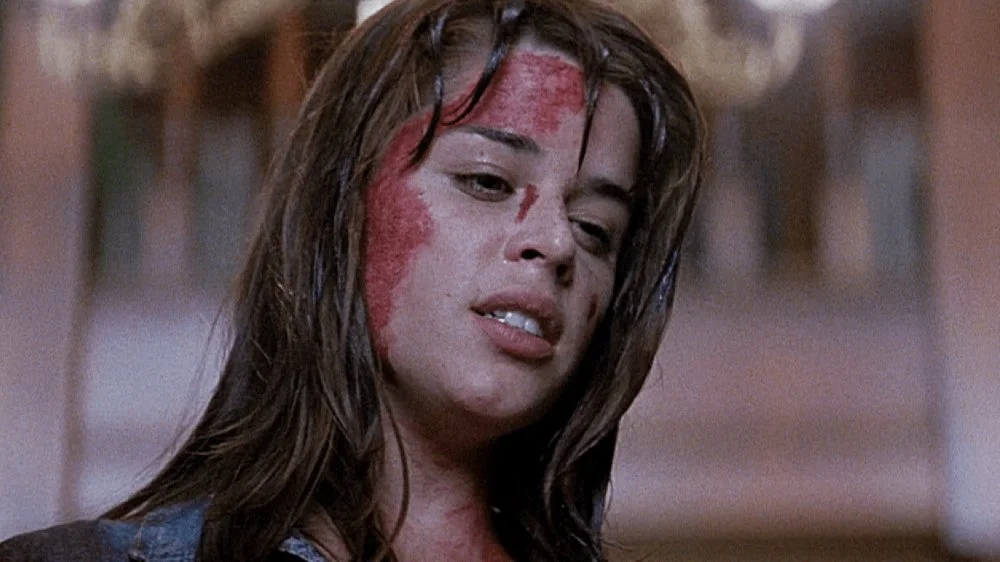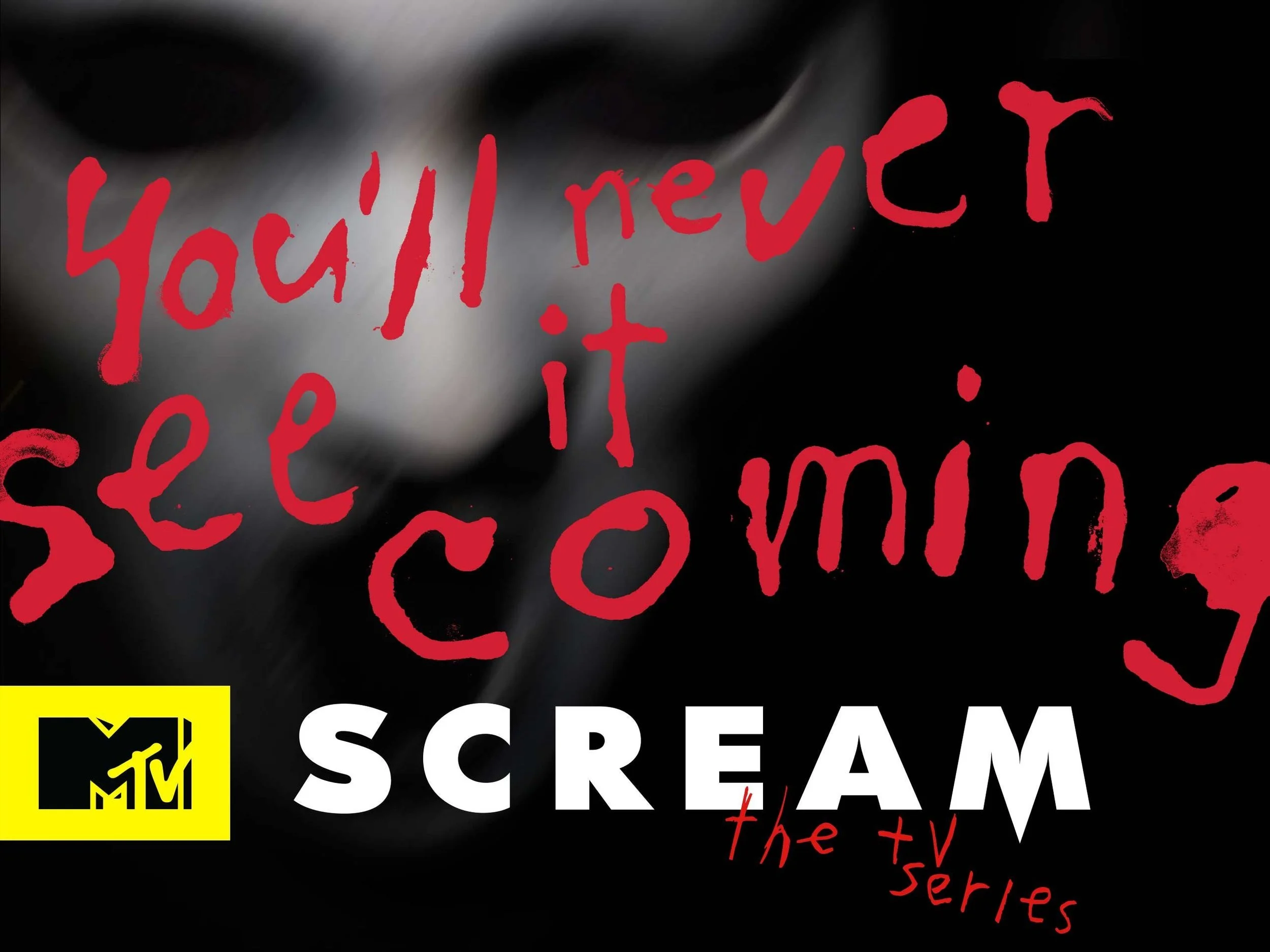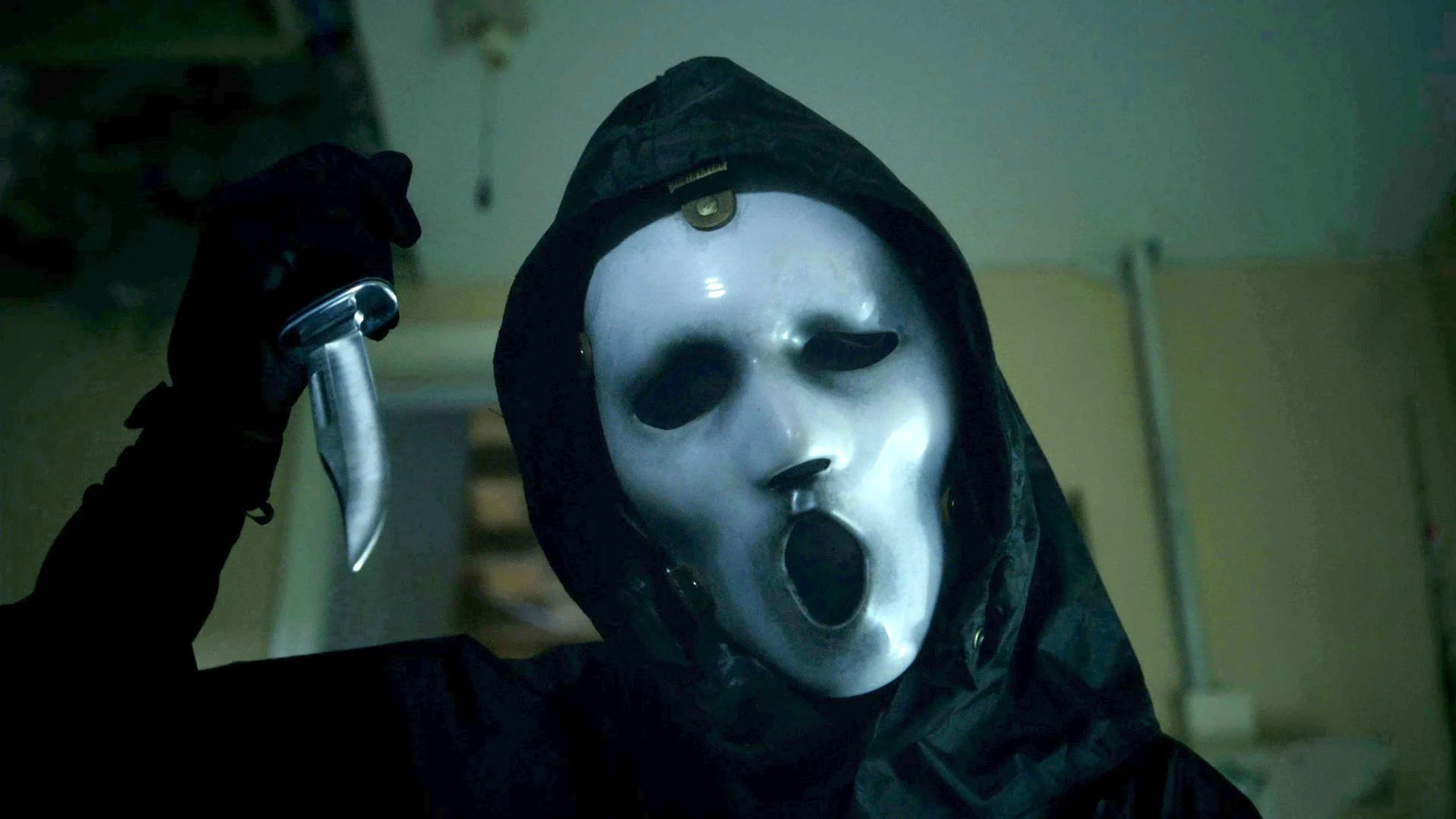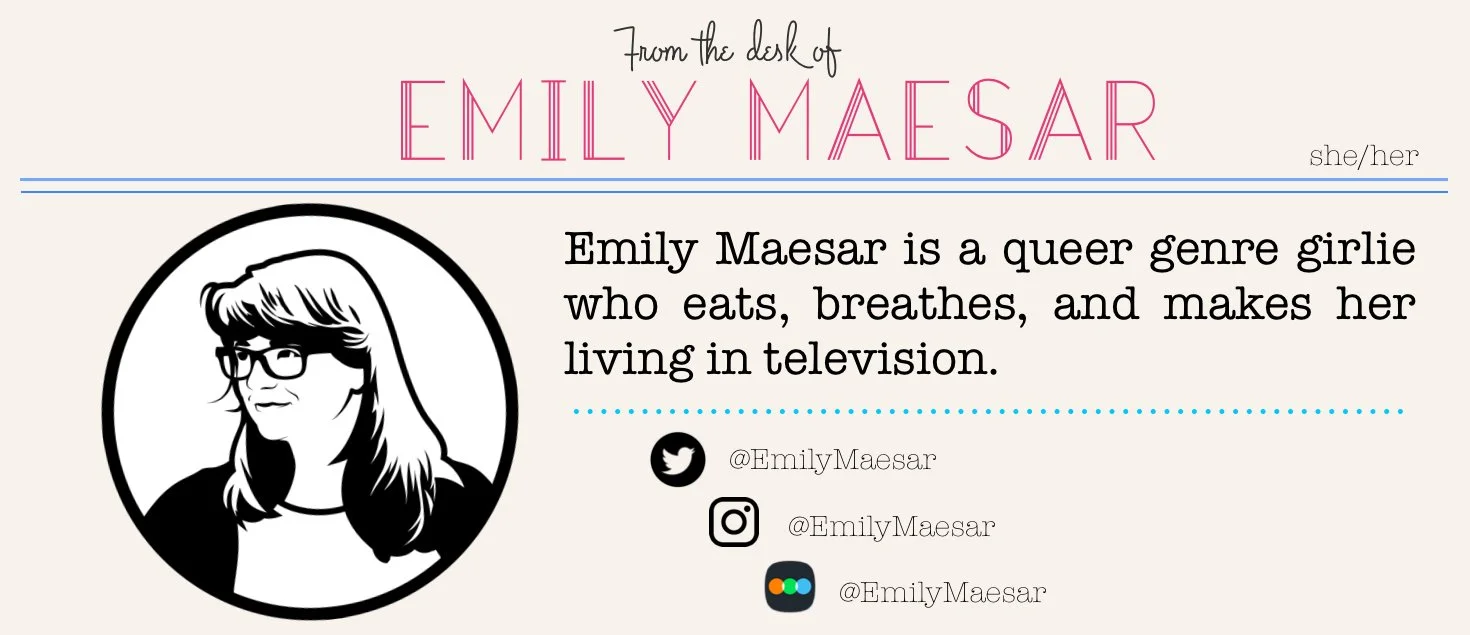A Red Right Hand: The SCREAM franchise so far, from Stab to MTV
by Emily Maesar, Associate Editor, TVJawn
NOTE: This feature contains spoilers for the entire Scream franchise (including the TV series), but EXCLUDING Scream 6. All the killers are named in order to talk about the franchise in its current state.
There are two horror films, the first in modern franchises, that I only made a few minutes into before having it turned off abruptly. Not because I got scared, necessarily, but because my mom realized what my sister was showing me and got angry because of how young I was. Classic. One of those films was Scream, which she was so real for, honestly. Drew Barrymore’s body hanging from the tree at the end of the opening scene haunted me for years and years.
Originally titled Scary Movie (a fact which is always funny to me, given the spoof franchise that followed Scream’s 1996 release) Kevin Williamson’s initial idea was inspired by a mix of the, then, contemporary Gainesville Spree killer and Williamson finding a window open in the house he was staying in—one that he hadn’t touched. Once the script had been written, however, the battle to get the film sold and made was an uphill one.
The first issue was the state of horror at the time, as the slasher genre was in hibernation (only to come back to life with the first film in the franchise) by the time we all collectively entered the 1990s. There were a few legacy films from classic ‘70s and ‘80s franchises at the beginning of the decade, but nothing like the times that Williamson had grown up in. The conservative nature of America rolling from the Reagan era into the Bush years had finally caught up with Hollywood, as the violence in the genre was being phased out. Until Scream, the majority of mainstream horror in the first half of the 1990s were essentially psychological in nature. That, or they were paranormal. Hauntings and demons ran aground, but those are rarely violent, even these days, in the same way a slasher film is.
And so Scream was a hard sell. But it did sell—to issue number two: the Weinstein brothers at Miramax. Once there, and after being asked no less than three times, Wes Craven signed on, having just made his second (and final) Freddy Krueger flick, Wes Craven’s New Nightmare. It’s an okay film that shares a lot of similarities with Scream 3, but is ultimately the lesser of the two endeavors. However, Craven was game to direct the first Scream film, and he helped bring back in a lot of the overt gore that Williamson had been forced to remove as part of the deal to buy the script.
When Scream was released in 1996, there was no real way of knowing the ways in which it would alter the horror film scene. But for better or for worse, Scream changed everything. We’re still living in those changes to the genre, over 25 years later, and there’s no end in sight to what Scream hath wrought. I love Scream, though, and don’t think there's a truly bad film in the bunch (though the TV series is a whole other conversation that we will be having)! Perhaps the cynical, meta-driven stories that came from Scream’s success are kind of a nightmare. That’s not the film’s fault, though. That’s good ol’ corporate misunderstanding of what actually made the films work, and what made people connect to the franchise so deeply. A few of the things that Scream often contends with over its 27-year existence includes the ever changing landscape of violence in media, fame through absolute infamy, and the gender dynamics of killing. These are some of the enduring tentpoles of the franchise, for good reason.
When it comes to violence in media, there’s nothing quite like the first film’s villain monologue. I talked about this in my October piece of You Can’t Sit with Us from 2021, where I wrote about Scream and Jennifer’s Body. When Billy (Skeet Ulrich) and Stu (Matthew Lillard) start hacking into each other, Syd, who’s forced to be at the center of their twisted little game, tells them they’ve seen too many movies.
“Now, Syd. Don’t you blame the movies. Movies don’t create psychos… movies make psychos more creative.”
And that’s always been one of the best substantive lines in the first Scream film, at least to me. Part Ulrich’s delivery and part as a commentary to the very present (both at the time and currently) idea that violent media makes people violent. It was something that was being debated from the time that Ronald Reagan took office in 1981, and likely even before that. From the PRMC, to the MPAA, to the ESRB—the content of media is always hotly contested. Even if it isn’t made for kids. And every organization gets a decade or so to make their case for ratings, censorship, and everything in between. Music was being left in the 1980s, just as films were taking center stage in the 1990s, with video games taking over in the 2000s.
But despite being the villain of the film… Billy’s right. Media matters, but this argument just isn’t useful. It’s reactionary, conservative, and deeply reductive. It treats all the people who consume media both like puppets and time bombs, neither of which are true. How the rest of the franchise handles this thought, though, is a bit less directly clear. You’ve got Timothy Olyphant’s Mickey in Scream 2 with his “I’m gonna blame the movies” plan. Which isn’t a bad plan for his sake, given the atmosphere at the time—he’s probably not wrong that the Christian Coalition would have paid his legal fees. Sidney’s half-brother Roman (Scott Foley) from Scream 3 doesn’t aim to blame the violence of the movies, though. Ultimately, he’s planning on framing Syd using the horror of Hollywood as her reasoning. Also not a bad plan.
Once the original trilogy ends, though, there’s a large time break in the franchise. And boy howdy did the culture shift in the meantime. The Scream franchise had always been meta and self-referential, to both the genre and to itself. But Scream 4 took it over the top. So, instead of blaming the “movies” as a general concept, the Stab movies (which are the meta films in the Scream universe that are made about the life and times of Sidney Prescott) are used as part of the potential motive for one of the killers (Rory Culkin’s Charlie). Along with the idea of “making his own movie.” Because Roman might have been an actual director, making Stab movies, but he wasn’t trying to make one out of the killings. That’s for the next generation.
Except that Jill (Emma Roberts) and Charlie aren’t making a movie, they’re basically making vlogs because that was the era of media that we were in when the film came out in 2011. It isn't until Scream 5 (aka Scream), that the motive for killers Richie (Jack Quaid) and Amber (Mickey Madison) is about making a movie. Though even then it’s more so about giving Hollywood the motivation to make a “good” Stab movie again, by giving them something real to base it on.
All of the motivations, compounded together, gives a good idea of what the Scream franchise has to say about violence in film. Billy’s not wrong, but society has changed. The advancement in technology and how fame can be acquired means that the possibility of fame, not the violence in horror films, is a much larger factor in people doing horrible things to obtain it. Those 15 minutes have to be earned, after all.
Okay, so what about that fame? Well, it’s always going to be fame through infamy. Even Syd’s celebrity isn’t because of anything good. But fame is so incredibly important to the Scream films, especially after the first one. Billy and Stu dreamed of being the Final Boys (joke’s on them) after a terrible and gruesome spree. Which… yeah. That’s what a lot of the killers aspire to for their endings. Jill dreams of being like her cousin, Sidney—the ultimate Final Girl. Mickey wants the media circus of a trial, like OJ Simpson’s. Richie and Amber want their story to be adapted into a new film in the Stab franchise. The only outlier is Roman, though he is a film director who’s capitalizing off the pain of his half-sister. (He also implies he’s the one who set the whole franchise in motion, so there’s always that.) If violence in media is the motivation the killers would give, or have given for them, after everything is said and done… then fame is the actual reason. And with the ways that American culture has developed around mass murder, there’s no doubt in my mind that fame through murder is the ultimate evil the films are commenting on.
And then there’s the show. Did you know there’s a Scream TV series? Three whole seasons of one, actually. Airing on MTV (Seasons 1 & 2) and VH1 (Season 3), the series is… not related to the main franchise at all. In fact, outside of the title and the eventual inclusion of the iconography of Ghostface (in Season 3), the series could be any other show. However, it does include elements of the three throughline concepts, so I think it’s worth talking about.
The first two seasons follow a set of high school students being terrorized by the “Lakewood Slasher.” It’s someone (or someones!) wearing the medical mask of Brandon James, a teenager who went on a killing spree during a Halloween dance in the mid-1990s, before being shot and killed by police at the lake. In the same way Sidney is the focal point of the films, because of the history of her mother, Emma (Willa Fitzgerald) seems to be the fixation of the Lakewood Slasher for similar reasons.
And the revealed killer in the first season (Piper, played by Amelia Rose Blaire, who is Emma’s half-sister and daughter of Brandon James) allows the Scream TV series to add to both the idea of what media violence in this new context is like, as well as what fame out of infamy looks like in 2015. It’s modern and niche in a way that our Scream 5 killers, trying to be immortalized in film forever, aren’t ultimately doing. Piper is a true crime podcaster, after all. So, not only is she getting content while she’s killing and building friendships with all her victims, but she would have had a helluva story to spin once it’s all said and done. Her partner in all this is Kieran (Amadeus Serafini), and while he spends the majority of the show being Emma’s boyfriend, he doesn’t have a real motive in all of this, other than his relationship to Piper. But Piper’s background is basically Roman, with a bit of Sam Carpenter (Melissa Barrera) from Scream 5 thrown in for fun. Which is to say that Piper’s motive is pretty clean, on top of the podcast of it all.
That’s just the first two seasons, though. Season three was a reboot of the series, with an entirely new cast, creative team, and location. Set in Atlanta and functioning as a six-episode mini-series, the third season of the show sees the actual use of the Ghostface mask (there was some contention during the original development about rights for it). It doesn’t have a lot to say about violence in movies, other than one of the killers, Beth (Giorgia Whigham), saying the kind of abhorrent, “I always knew I was a sociopath. I mean, why do you think I love horror movies so much?” Which. To be completely honest, the first two seasons of Scream are kind of bad, although I was curious enough about who the killers were to not look it up. There’s a real disconnect about what made the films so fun, and it actually doesn’t have anything to do with the lack of Ghostface (though it doesn’t help). Season 3 is a return to a form the series never actually had, but this line is such a misstep that it actually made me wonder if even this season of the show understood what people liked about the movies. It’s a good reboot overall, though, and you can skip the first two seasons if you’re just in it for the Ghostface vibes.
Despite not always following the first two concepts that the films are usually contending with, however, the one thing that both stories in the Scream TV series do is really hold onto the gender dynamics of killing set up in the four movies before it. Often sexual, or pseudo-sexual, the only entries in the Scream franchise where the killers aren’t a man and a woman are Scream and Scream 3. Although Billy and Stu do have a pseudo-sexual relationship (as many fans and actors in the films have commented on). Their crimes do also include the rape and murder of Sidney’s mother, Maureen, the year before the events of the first film. The first part of that crime is something I don’t think we talk enough about, honestly. In Scream 3, Roman becomes the ultimate outlier because he’s the only single killer in any part of the franchise. He gets some vaguely supernatural plot armor because of it, but he’s truly the odd man out here.
Otherwise, all the killers are teams of two, and are always a man and a woman. Mickey and Mrs. Loomis are the killers in the second film (although that movie got rewritten so many times because of the script leaking online), and they’re the only set of killers who don’t have a sexual relationship with each other. It’s much more deranged mother and son, you know. In both Scream 4 and the third season of the TV series, the women in those couples are using their sexuality to manipulate the men into helping them kill. However, in Scream 5 and the first two seasons of the show, those relationships appear to be earnest to some degree. Even if they’re absolutely bananas.
There are two major reasons for this gender dynamic in the franchise, at least by my estimation. First, the vibes of men menacing the Final Girl vs. women menacing her allow for very different scenarios. Being able to have both really opens up the options for the Final Girl to have an emotional reaction to betrayal and genuine fear. Second, though, is the queer factor. Kevin Williamson is openly gay and does have writing credit on three of the five current (until Scream 6 and then it’s half and half) films, though he didn’t work on the show. Two of his three sets of killers fall into this dynamic, but they’re also either non-sexual or a manipulated sexuality. I think that for everybody else (Scream 3 excluded because Roman is a special boy) there was something too queer about having both the killers be young men, given the Billy and Stu of it all. And I find that deeply fascinating.
With Scream 6 coming out, the history of the franchise is well documented and cemented into the horror scene. Even with its misses (both in front of the camera and behind the scenes, looking at you Scream 6 for not paying Neve Campbell to come back), there’s no denying that Wes Craven and Kevin Williamson brought back the slasher genre and allowed horror to open back up at a time when the strings of censorship were tightening. A feat worthy of all the admiration we show the franchise, if nothing else.








